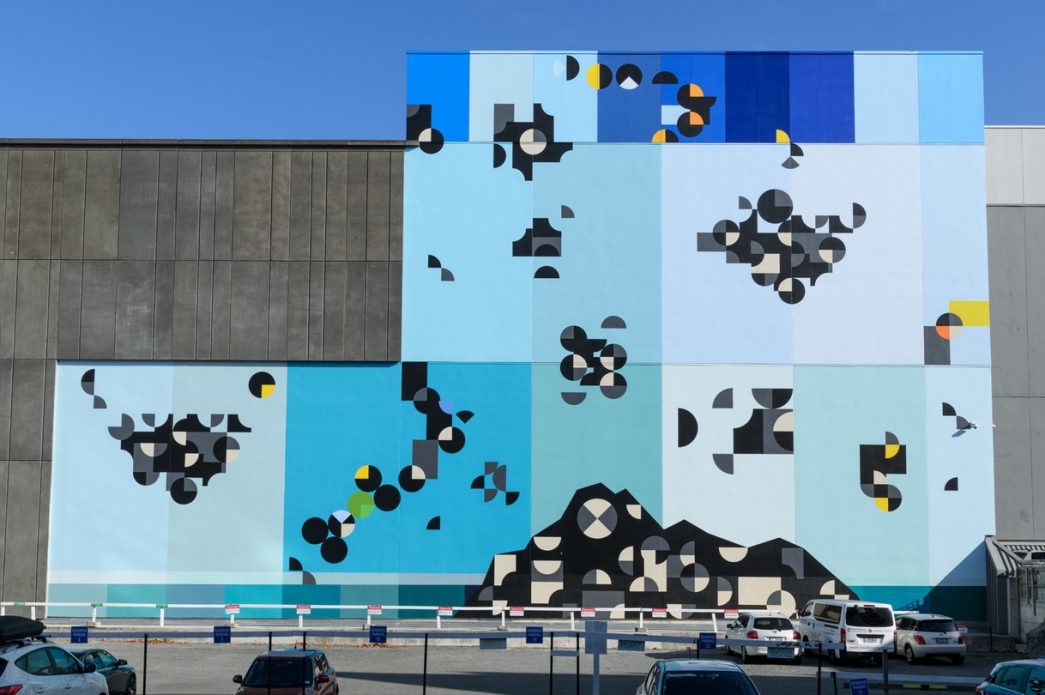Te Tāhū o ngā Maunga Tūmatakahuki & Whakatakina te Waiwhetū





Details
Christchurch Art Gallery Te Puna o Waiwhetū, Aotearoa/New Zealand 2020
Exterior & interior artwork: Commissioned by Christchurch Art Gallery Te Puna o Waiwhetū
Exterior artwork title: Te Tāhū o ngā Maunga Tūmatakahuki, acrylic on concrete wall
Interior artwork title: Whakatakina te Waiwhetū, 2020, acrylic on wall
Photos courtesy of: Christchurch Art Gallery Te Puna o Waiwhetū . All rights reserved, 2020.
Photographer: John Collie
Context
Te Tāhū o ngā Maunga Tūmatakahuki
Te Wheke
25 May 2020. Posted by Felicity Milburn
There is a gorgeous new addition on the side of Te Puna o Waiwhetū. Artist Kelcy Taratoa has created a wall work to replace Kay Rosen’s Here Are the People and There Is the Steeple, which was in place for eight years. Its title is Te Tāhū o ngā Maunga Tūmatakahuki (see below for an explanation) and it was created in association with our soon-to-be-revealed exhibition Te Wheke: Pathways Across Oceania. The exhibition’s themes of exploration, belonging and connection were a starting point for Taratoa’s thinking, and he worked with the support of mana whenua, including Nathan Pohio, to ground the work in local narratives that relate to discovery and whakapapa.
Within the brightly coloured, geometric composition, you’ll see shapes that refer to land, sea and sky: a series of islands, a tall maunga (mountain) and a kāhui whetū (cluster of stars). All relate to the early explorers who travelled vast distances across Te Moana nui-a-kiwa (the Pacific Ocean), including to Aotearoa New Zealand. They used the stars and other natural phenomena for navigation, so the star cluster alludes to their skills and courage. As Taratoa has said:
“The title is intended to cast our minds to the senior mountains on Mo’orea, Tahiti, which hold significant mana and whakapapa. These sacred mountains, along with the stars and other natural phenomena, are the navigational temples that guided our ancestors throughout the Pacific and to Aotearoa New Zealand.”
Taratoa’s recent works have often responded to customary artforms. He’s interested in how traditional imagery can be deconstructed and reformulated, opening up what he describes as “a suspended space that allows for both customary and non-customary frameworks to conceptually co-exist in the mind of the viewer, with past and future held in the present.”1 The interwoven elements of the Gallery’s painting echo the overlapping forms and rich symbolism of the latticework art of tukutuku. This layering relates to the Māori concept of whakapapa, which literally means a series of flat layers placed on top of each other. Whakapapa refers to the genealogical links that connect people – both in the present world, and also through links to ancestors and significant places throughout the Pacific. In Taratoa’s work, weaving and binding become a metaphor for the power of whakapapa (genealogy) to unite people in a common kaupapa, or purpose. The title likens the ancestral mountains to the binding stitch that secures the horizontal and vertical elements in tukutuku.
The star-filled sky also grounds the work firmly in this place by echoing the Ngāi Tahu name of the Gallery building: Te Puna o Waiwhetū – the clear spring in which stars are reflected. With the sky at the top, and the land at the bottom, the work suggests how our sense of belonging is grounded in the whenua or land – as our tūrangawaewae / place to stand – and also how we look to the sky for inspiration and direction. It clearly signposts the Gallery, and by extension Ōtautahi, as a place of inclusion and connection, a statement made especially relevant by everything the city has weathered over the past ten years.
Over the next couple of weeks, another work by Taratoa will begin to take shape – a wall painting on the first-floor balcony to signal the entrance into the Te Wheke spaces designed by Taratoa and brought to life by our very own exhibition team. It is called Whakatakina te Waiwhetū (‘to pursue the many stars reflected in the sacred spring’). It also acknowledges those early explorers and the idea of whakapapa, while combining forms that relate specifically to Ngāi Tahu. A large tohorā (whale) remembers the ancestor Paikea, whose descendant Tahu Pōtiki provides Ngāi Tahu (the people of Tahu) with their tribal name. Circular forms recall the story of the arrival of Arai Te Uru, an ancestral waka that left Hawaiki Nui to arrive in Te Waipounamu. When struck by four waves, the kumara and fishing net inside spilled out, forming the distinctively shaped Moeraki Boulders. Also visible is the familiar silhouette of Aoraki, the paramount ancestor of Ngāi Tahu.
Te Wheke: Pathways Across Oceania opened Saturday 30 May 2020.
Notes
https://christchurchartgallery.org.nz/exhibitions/kelcy-taratoa
Text: Courtesy of Christchurch Art Gallery Te Puna o Waiwhetū.